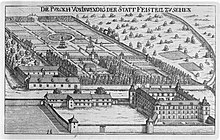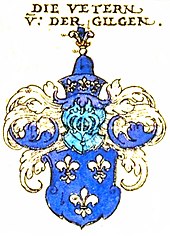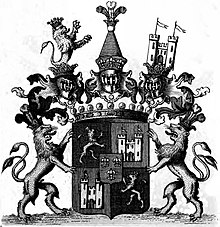Cousin of the Lily
The Counts Vetter von der Lilie, Freiherrn zu Burg Feistritz are an Austrian noble family that originated in Lower Styria .
history


According to family tradition, the "cousins of the lily" should originate from the Valois family , and according to Kneschke they should be of Bavarian origin. The family's origins are in the dark. The genealogy can be only up to the time of Emperor Charles V determined track.
According to Paul von Stetten , the medieval cousins of the Gilgen, who were related to the coat of arms, and the cousins of the panther animal from Donauwörth , who were related to them , came as families of the late medieval patriciate of the imperial city of Augsburg . By the time the Reformation began , individual lines had already passed into the Bavarian landed nobility, while they died out in Augsburg. In 1579 Adam Vetter von der Gilgen was, among other things, governor of the Regensburg bishopric and ducal Bavarian councilor in Munich, as well as president of the court council, and lord of Oberköllnbach . In 1596, Adam Vetter von der Gilgen is said to have died as the last person with this name.
The progenitor of the Styrian family line, Melchior Vetter, owned besides the castle and rule (Windisch-) Feistritz in the (Slovenian) Lower Styria , Tüffer, Thurnisch, a farm in Pettau and a house in Graz and received a letter of coat of arms on March 25, 1532. The family was included in the Styrian estates in 1587 . Johann (Hans) Vetter († May 8, 1594) was President of the Inner Austrian Court Chamber and Privy Councilor . The grandson of Balthasar and son of Johann, Friedrich Freiherr von Vetter, was chief steward on the Windisch and Petrian border and received the baron status on July 8, 1660.

With a diploma from February 1, 1653 in Regensburg , Johann Balthasar Vetter († September 27, 1661) was given to Emperor Ferdinand III. raised to the rank of imperial count and was henceforth allowed to call himself cousin Graf von der Lilie, Freiherr zu Burg Feistritz . This increase in status also applied to his descendants and his brother Johann Weikhard. In 1660 Balthasar and his brothers bought Neuhübl / Neuhübel , a village in the Moravian Kuhländchen with a castle ( ) and Mayerhof, for 16,500 florins and in 1672 they left it to their brother Ferdinand Fortunat.
![]()
Soon after, the family also settled in Silesia. After Sinapius, Ferdinand Fortunatus († 1717) acquired the Miestitz castle and manor in the Duchy of Opole . He called himself Count Vetter von der Lilie, Freiherr zu Burg Feistritz, Herr auf Neuhübel Sikowitz, Engelswald, Kl.-Olbersdorf, Gortendorf, Nieder-Steinau and Miestitz. Karl Joseph, a descendant of Fortunat, the Prince-Bishop of Olomouc, Count of Liechtenstein Councilor and fiefdom lawyer in the Margraviate of Moravia, also acquired Kattendorf in 1762 .
For a long time, the cousins of the lily and the cousins of Lilienberg were assigned to a family (cousin), which from a heraldic point of view is not tenable, as there are two completely different coats of arms.
Personalities
- Karl Josef Franz Felix Fortunat Count Vetter von der Lilie (* December 10, 1719 - October 4, 1792), Baron of Feistritz Castle, Lord of Neuhübel, Sikowitz, Engelswald, Kl.-Olbersdorf, Gortendorf, Nieder-Steinau and Miestitz, was the prince-bishop of Olomouc, Count of Liechtenstein, councilor and fiefdom assessor in the margraviate of Moravia, and episcopal fiefdom judge. He was married to Maria Luisa Ludovika Countess Orlik Freiin von Laziska (born July 29, 1722 in Rudelsdorf / Lower Silesia: † January 22, 1802) since June 12, 1740 .
- Ferdinand Graf Vetter von der Lilie (* July 8, 1812 in Neuhübl ; † September 15, 1882 in the USA ) was an Austrian officer, in 1852 a colonel and commander of the 3rd Uhlan Regiment, then major general (1866), and finally on March 28, 1876, Lieutenant Field Marshal . He was married to Josephine von Wachtler since October 13, 1827 (* October 13, 1827, † May 16, 1902).
- Gustav Nepomuk Karl Ferdinand Count Vetter von der Lilie (August 14, 1819 in Neuhübl; † March 27, 1897 in Sedlnitz , Moravia), was an imperial and royal major general (April 23, 1873).
- Felix Graf Vetter von der Lilie (born March 18, 1830 in Neuhübl; † November 21, 1913 ibid), was the son of Franz Graf Vetter von der Lilie (1789–1831) and Antonia Countess Braida von Ronsecco and Cornigliano , among others Allodialherr von Neuhübel, Fideikommißherr von Tüffer, married on October 25, 1855 to Countess Ida Arz von und zu Arzio-Vasegg (born July 1, 1833 in Wigstein , Austrian Silesia , † September 29, 1903 in Neuhübl), initially dedicated himself to this Army service, but since 1856 managing its Moravian estates. He was out for several years a member of the Imperial Council and 1884-1906 Governor of Moravia .
- Maurice Graf cousin of the lily , son of the above, (born August 22, 1856 in Opava , † 20 September 1945 in Retz), studied in Vienna Law , joined in 1879 as an administrative officer in the civil service and, after several years in Bohemia and Moravia Appointed to the Ministry of the Interior in 1888. In 1889 he came to Boskowitz in Moravia as district captain , then to Brno as governor's council . He left the civil service and was a member from 1897, from February 8, 1901 to January 1907, the first President of the House of Representatives .
coat of arms
1653: The family coat of arms is quartered in black and red with a blue heart shield , in this three (II. And I) silver lilies . I. and IV. A crowned, golden lion, turned against the division . II. And III. a silver castle with two pointed towers, double crenellated wall , closed black gate, two windows in each tower, five (III., II.) bullet holes in the outer wall on both sides of the gate. Three helmets above the count's crown, including I. and III. crowned. I .: The lion on the crown , the ceilings black and gold. II .: Blue high cap with the same cuff , on this side by side three silver lilies, on the top of the cap a golden ball on the top a golden crown decorated with three blue-gold-blue ostrich feathers. Ceilings are blue-silver. III .: The castle on the crown. The blankets are red-silver. The complete coat of arms includes two crowned, golden lions as shield holders . The lion's crown on the right is decorated with three black, gold and black feathers, the one on the left with three red, gold and red ostrich feathers.
Possessions
After the Second World War the family lost all possessions in Bohemia and Moravia. The rulers of Neuhübel were the Counts Vetter von der Lilie. They had their crypt in Klein-Olbersdorf .
Hautzenbichl Castle in Styria had been in their possession since 1883, but fell to the Pranckh family in 1954 through the marriage between Pilgrim Freiherr von Pranckh, Herr auf Pux and Pachern, and Maria Antonia Countess Vetter von der Lilie .
In 1982 the family acquired the ruinous Neuhaus Castle (Styria) and had it reconstructed.
literature
- Constantin von Wurzbach : cousin of the lily, the count, genealogy . In: Biographisches Lexikon des Kaiserthums Oesterreich . 50th part. Kaiserlich-Königliche Hof- und Staatsdruckerei, Vienna 1884, p. 237 ( digitized version ).
- Constantin von Wurzbach : cousin Count von Lilienberg, coat of arms . In: Biographisches Lexikon des Kaiserthums Oesterreich . 50th part. Kaiserlich-Königliche Hof- und Staatsdruckerei, Vienna 1884, p. 239 ( digitized version ).
- Berthold Bretholz : The count cousins of the lily. A genealogical study . Winiker & Schickardt, Brno (1900), OBV , 11 pp.
- Vetter von der Lilie in: Meyers Großes Konversations-Lexikon , Volume 20. Leipzig 1909, p. 130.
Web links
Individual evidence
- ^ Ernst Heinrich Kneschke : German count houses of the present: in heraldic, historical and genealogical relation , 2nd volume LZ, Verlag TO Weigel, Leipzig 1853, p. 598 ff.
- ↑ Meyer's Large Conversation Lexicon on zeno.org
- ^ Paul von Stetten: History of the noble families in the free imperial city of Augsburg , Augsburg 1762, p. 75 ff.
- ↑ Historio-Topographica , 1723, p. 142 f. , Collection of the Baierischen Kreisrechts , 1764, S. 148 ff.
- ↑ Contributions to the Nördlingische sex history , Volume 2, 1803, p. 506.
- ^ Karl Schmutz: Historisch-topographisches Lexicon von Steyermark , Si – Z, Volume 4, printed by Andreas Kienreich, Graz 1823, p. 259
- ^ Ernst Heinrich Kneschke : New general German Adels Lexicon , Volume 9, Verlag Georg Olms Verlag, Hildesheim 1973, p. 381 ff.
- ↑ Bertold Bretholz: The count cousins of the lily . Brno 1901
- ^ A b Franz Joseph Schwoy: Topography of the Markgrafthum Moravia: Prerauer, Znaymer and Iglauer Kreis , Volume 3, printed by Joseph Hraschanzky, Vienna 1794, p. 133
- ↑ Johannes Sinapius: Des Schlesischen Adels Anderer Part or continuation of the Schlesische Curiositäten , Volume 2, publishing house and printing Michael Rohrlach, Breslau and Dresden 1728, p. 267 f.
- ^ Antonio Schmidt-Brentano: The kk or kuk Generalität 1816–1918 , Austrian State Archives, 1907, p. 193
- ↑ Entry on www.coresno.com


